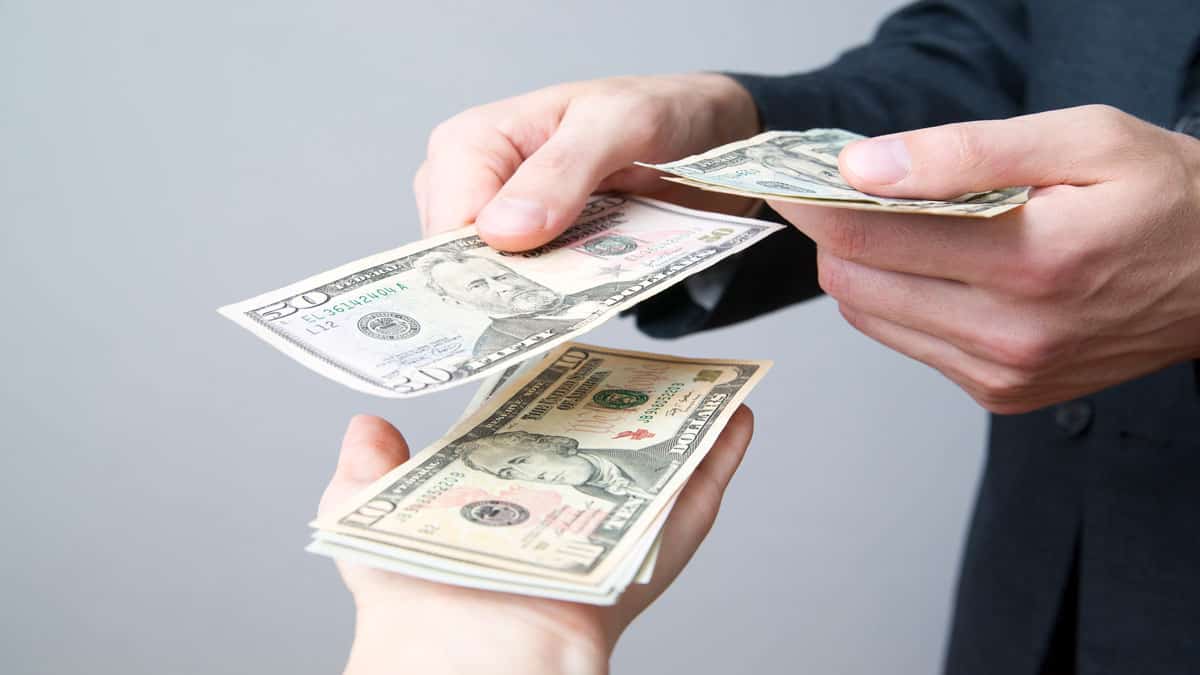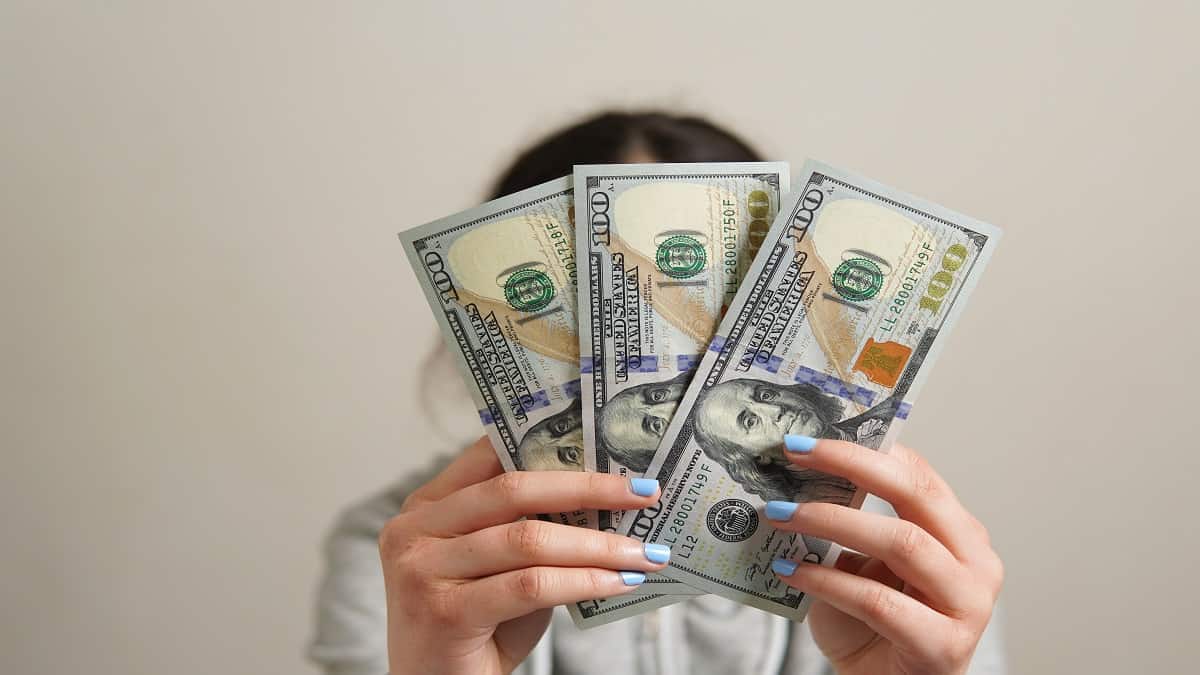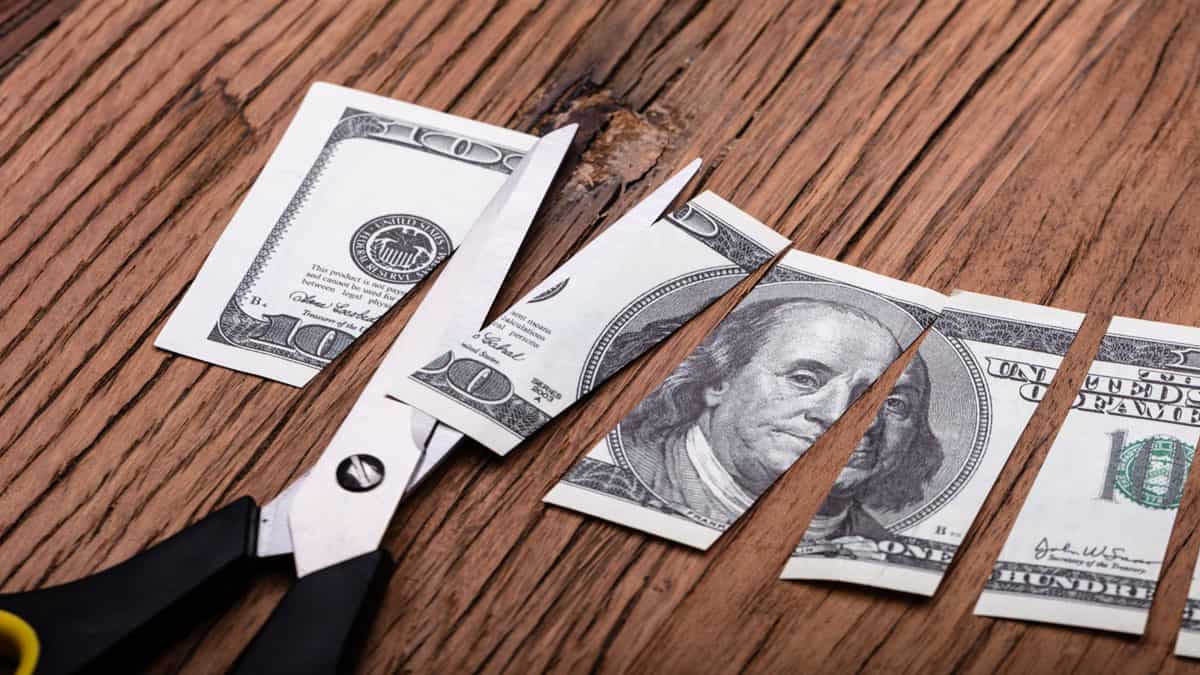THIS POST MAY CONTAIN AFFILIATE LINKS. PLEASE SEE MY DISCLOSURES. FOR MORE INFORMATION.
Raise your hand if you hate paying your mortgage every month.
Not only is it your largest monthly bill, but it feels like you will never pay it off since most of your payment goes towards interest.
Frustrating times for sure. But there are ways to pay off your mortgage early. In fact, I highlight 11 tricks to pay off your house early in this article.
You can pick out the one that suits you best, or find a way to combine multiple tips to pay off your mortgage faster.
By slashing your mortgage out of your monthly budget, you could earn less, and still get by financially.
#1. Use Tax Refunds

According to the IRS, the average refund for 2022 is a whopping $3,093! I’m not going to get into the debate about getting such a large tax refund here, but I will show you the power of using your refund to make a large lump sum payment on your mortgage.
Let’s say you bought a house and took out a mortgage with a 30-year loan term for $200,000 at 5% interest. You pay the balance due every month except for May.
In May, you make an additional one-time extra payment of $3,039, which is your refund. What effect does this have? If you do this for five years, you will shave more than four years off your mortgage and save over $39,000 in interest!
Use this mortgage payoff tip for ten years and knock off close to 7 years and save over $59,000 in interest! Use this trick for the entire length of your mortgage, and you knock off over 10 years and save over $71,000 in interest!
It can be tempting to spend your refund on something else. But if you can put it towards your mortgage debt, you will save a ton of money.
I’ll even make a compromise with you. Take 10% of your refund and spend it however you want. Then take the other 90% and make a lump sum payment.
Your savings and payoff date won’t be as exciting as what I showed you above, but it’s better than spending the entire refund.
#2. Make Biweekly Mortgage Payments

Another step to paying off your mortgage early is creating a biweekly payment system. Biweekly payments take your monthly payment and cut it in half so that you make a half payment every other week or twice a month.
The idea is that if you get paid biweekly, there are 26 pay periods in a year. If you make 26 half payments, you make 13 total payments, or one extra payment a year.
This one extra payment each year adds up over time. Some banks offer to do this for you, but they often charge extra fees, like a set-up fee or other ongoing fees.
You can skip the fees and do this yourself. But don’t simply mail in half of your payment every other week. Most banks won’t process it that way.
They will wait until they receive your total payment amount and then process it. In other words, they will sit on the half payment you sent in until you send in the other half.
Then they will apply the total payment to your account. Instead, take your payment and divide it by 12. You then pay this amount as extra principal each month for the year.
So let us use the example above of a $200,000 mortgage at 5% for 30 years. Your monthly mortgage payment is $1,074. If you divide this by 12, you get $89.50. Each month you pay $1,163.50 towards your mortgage.
This total is your regular payment of $1,074 and the additional $89.50. There is usually a line for an additional principal payment on the remittance slip you send along with your check. Put the extra $89.50 on this line.
If you pay online, there is usually a place for noting extra principal. Come to the end of the year, and you will have made one extra mortgage payment, the same as setting up a bi-weekly mortgage payment.
Following this technique will knock off close to 5 years on your mortgage, and the interest you save is over $33,000.
#3. Use Credit Card Rewards

Wouldn’t it be great to use credit card rewards to repay your mortgage faster? You can!
We had our last mortgage through Wells Fargo, and one day when I logged into our account, I saw a note about their Home Rebate Card.
For the first six months, you earn 5% cash back on gas, groceries, and drugstore purchases and 1% on everything else.
After six months, you earn a flat 1% on purchases. The nice thing about the card is that there is no annual fee, and the cashback gets automatically transferred to your mortgage principal.
Unfortunately, Wells Fargo retired this card.
But you can still do this mortgage payoff trick and pay off your mortgage fast. Here is the process:
- Open up an American Express Blue Cash Preferred Card.
- Put your groceries and gas on this card since you earn 6% and 3% cash back, respectively.
- Open up a CIT Bank savings account.
- Redeem the cash back on the Amex card for a statement credit.
- Transfer that amount from your checking account to your CIT Bank savings account.
- At the end of the year, use this money to make an extra mortgage payment.
You make the transfer from checking to savings since you never had to pay the amount you took a statement credit for. If you spend $150 a week on groceries and $50 a week on gas, you would earn $625 a year in cash back.
Apply this to your mortgage once a year, and you knock off over three years and save more than $20,000 in interest! Of course, you want to avoid going into debt when doing this.
Otherwise, the point of paying off your mortgage early is lost since the interest payments will cancel out the cash back you earn. So make sure you are smart about how much you spend when taking advantage of this mortgage payoff trick.
#4. Pay Extra At The Start

As I mentioned at the beginning of this post, when you first start making payments on your mortgage, you pay mostly interest. As you move towards the end of your mortgage, you pay mainly the principal.
This is because the mortgage company wants their money back first. Being smart and making extra payments at the start of your mortgage will lower your principal balance faster, saving you thousands of dollars and paying off your mortgage early.
Let’s use the same example from earlier ($200,000 loan at 5% for 30 years). Only this time, we will make an extra $100 payment each month for five years.
Doing this shaves off close to 2 years of your mortgage and saves close to $17,000 in interest. If you can afford to put $200 extra towards your monthly mortgage for the next five years, you knock off two years of your mortgage and save over $31,000 in interest.
And if you can always put $200 extra towards your mortgage, you will pay it off nine years early and save $61,000 in interest.
#5. Refinance

When you refinance, you either get a lower interest rate or shorten the term of your mortgage. Doing this will help you pay off your mortgage faster and save money.
Sometimes, when interest rates drop by a reasonable amount, you can shorten your term and interest rate and still have the same payment.
The amount of your savings will vary based on your mortgage rate, the loan term, and your loan balance. If you refinance from a 30-year mortgage to a 15-year loan, you will have a higher monthly payment in most cases.
But you will save thousands of dollars in interest because you shortened the term. The main downside to refinancing is the closing costs.
Typically they run between 2% and 5% of the loan amount. You could roll them into your new mortgage, but you are also paying interest on that money.
You are better off just paying the closing costs out of your pocket and not rolling them into the refinance. Some banks will offer no closing cost refinancing, which can be a great way to save some money.
Just compare their rate to another bank to ensure they aren’t charging you a higher interest rate. Another downside is a cash-out refinance, where you take out the equity in your home and end up with a bigger home loan than you had before.
While it can be tempting to access the equity you built up, the larger home loan will make it harder to pay off early.
#6. Pretend To Refinance

Because of the work involved with refinancing and the closing costs, there is another option to save money and pay off your mortgage fast. It’s called a fake refinance.
Simply use a mortgage calculator to determine how much a monthly payment would be on a refinance. Then commit to making that payment monthly without spending the money to refinance.
For example, let’s use the same numbers, a $200,000 mortgage for 30 years at 5%. A refinance of $200,000 at 3.25% on a 15-year mortgage would have monthly payments of $1,400.
Right now, you are paying $1,074 per month. If you don’t refinance and are five years into your mortgage and start paying $1,400 each month, you will pay your mortgage off ten years sooner and save close to $55,000 in interest charges.
That is some serious savings! The only catch here is that you must be committed to paying the fake refinance amount rather than just your standard payment.
Also, you will not get a lower monthly payment than you would if you completed a refinance.
#7. Round Up Payments

Rounding up your payment is also a little-known way to pay down your mortgage quickly. As I mentioned, your current payment is $1,074.
What if you rounded up to $1,100 per month? That is just $26 more each month. While you would only knock 2 years off your mortgage, you would save over $10,000 in interest charges.
A couple of dollars doesn’t sound like much, but it makes a difference.
On our mortgage, if I pay just $6.85 extra per month, I save over $3,300 in interest over the life of the loan. So don’t think a couple of extra dollars isn’t worth it.
Put anything extra you can towards your mortgage each month. To help with this, use Qapital. This app rounds up purchases and puts the money into a savings account.
Let the roundups accumulate for the year, then make one extra payment on your mortgage.
#8. Recast Your Mortgage

If you are not interested in refinancing or interest rates are higher than your current rate, you can see if you have the option to recast.
Recasting is when you update the payment based on a lower principal balance, and remaining term, while keeping the same interest rate.
Some mortgage lenders will allow you to recast, while others won’t, so it is important to ask. You often need to have a mortgage for at least two years and have paid down the mortgage loan by $20,000 or more.
The benefit of this option is that when you refinance, you start the process over again. You could save tens of thousands of dollars in interest by choosing to recast instead.
#9. Paying Extra And Rounding Up

For this example, we will round up $26 each month and pay an additional $125 each month. So our new payment is $1,225 per month.
With this method, you knocked off about eight years and saved around $50,000 in interest. Not bad for a small sacrifice, but we couldn’t cut a 30-year mortgage in half. Let’s try another combination.
#10. Biweekly Payments And Your Tax Refund

While the above option is great, let’s combine our tax refund and a biweekly payment.
Add $72 to your regular payment each month and use your entire refund to pay off the mortgage early. Combining both options will knock off 12 years and save over $82,000 in interest.
The only catch here is that a $3,000 refund each year is not a given. It could change, which could change your mortgage payoff as well.
This gets you closer, but you still aren’t able to pay your mortgage off in half the time.
#11. The Most Brilliant Way To Pay Off Your Mortgage

Finally, here is the fastest way to pay off your 30-year loan. It will allow you to cut a 30-year mortgage in half.
This is for people who want to destroy their mortgage as quickly as possible. To do so, we will use the following approach.
- Use your tax refund. We will assume the average refund of $3,000 but only use $2,000, so you can do what you want with the rest. This will also help us in the coming years since a refund can change depending on your financial situation.
- Open cash back credit card. We will assume $1,000 in rewards yearly to pay extra on the mortgage.
- Round up. We will use Qapital to round up our purchases and transfer that money to our mortgage annually. We will assume $750 in annual roundups.
- Pay extra. Finally, we will make additional payments of $150 extra a month towards the mortgage.
What is the result of all of this? You will pay your mortgage 15 years early and save over $98,000 in interest.
Of this extra amount we are paying each month, you only need to come up with $150. This is because the credit card cashback and the roundups from Qapital are from your spending.
How Can I Pay Off My 30-Year Mortgage In 10 Years?

No one option will help you to pay down a 30-year loan in 10 years. You are going to have to use a combination of ideas.
Just know that it will take sacrifice. Let’s go back to our example of a 30-year mortgage at 4% for $200,000 with a payment of $955. each month
To pay this off in 10 years, you must pay an extra $1,070 monthly. Combining a tax refund, extra payments, and then recasting your mortgage might be options in this situation.
How Can I Pay Off My Mortgage In 7 Years?

Paying your mortgage in 7 years will take a more significant commitment than paying off your mortgage in 10 years.
With a $200,000 loan for 30 years at 4%, you must pay an extra $1,765 monthly. While not impossible, you do need to use the ideas I outlined above to find the ones that will make this a reality.
Is It Better To Get A 15-Year Mortgage Or Pay Extra For A 30-Year Mortgage?

If you can afford the monthly payments, a 15-year mortgage is the better option.
This is because you will pay a lot less interest and be mortgage-free 15 years sooner. For example, let’s look at $200,000 at 4% for both 15 years and 30 years.
With the 15-year mortgage, you pay less than $67,000 in interest. With the 30-year mortgage, you pay close to $144,000 in interest. That is a difference of more than $77,000 in interest alone!
Read More From Money Smart Guides

With inflation rising, your monthly bills are likely getting out of control. Luckily, there are some simple steps you can take.
Use this guide to help you save up to $7,000 a year on your monthly bills.
SLASH YOUR MONTHLY BILLS AND SAVE
Make Money While You Sleep

Yes, you can make money while you sleep. There are a handful of jobs out there that will earn you an income even after you stop working for the day.
The trick is finding the right one for you.
HOW TO MAKE MONEY WHILE YOU SLEEP
Fun Money Saving Challenges

Do you find it boring to save money? If you are motivation by turning things into a game, check out these money saving challenges.
There is a game for you that will make saving fun and exciting so that you make it a priority to save money.
49 FUN MONEY SAVING CHALLENGES
How To Save Like A Millionaire

Many of us save some money which helps us to be able to retire one day and enjoy a better life.
But what if you knew how to save like a millionaire? Knowing this could help you to become wealthier than you can imagine.
HOW TO SAVE LIKE A MILLIONAIRE
Dave Ramsey’s Baby Steps

Using Dave Ramsey’s Baby Steps is great for getting your finances back on track.
But you could do better with a few simple tweaks to his system.
I have over 15 years experience in the financial services industry and 20 years investing in the stock market. I have both my undergrad and graduate degrees in Finance, and am FINRA Series 65 licensed and have a Certificate in Financial Planning.
Visit my About Me page to learn more about me and why I am your trusted personal finance expert.

